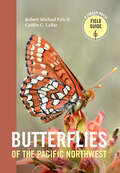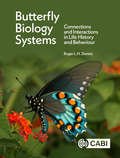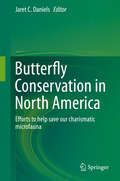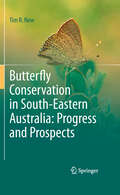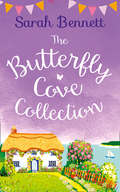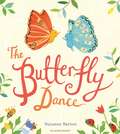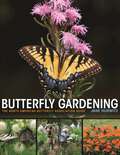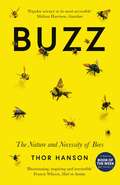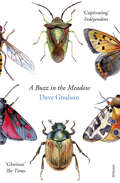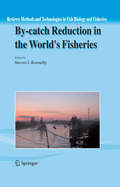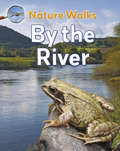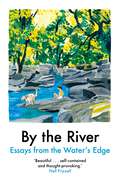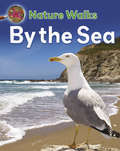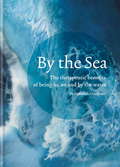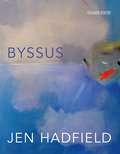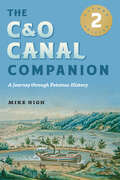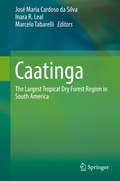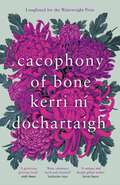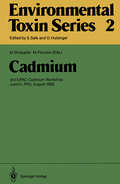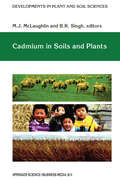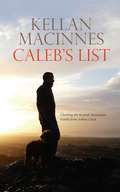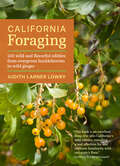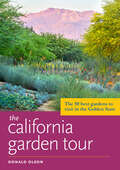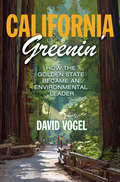- Table View
- List View
Butterflies of the Pacific Northwest (A Timber Press Field Guide)
by Robert Michael Pyle Caitlin C. LaBarA comprehensive guide to the butterflies of the Pacific Northwest from the region&’s foremost butterfly experts.
Butterfly Biology Systems: Connections and Interactions in Life History and Behaviour
by Roger L DennisIn Butterfly Biology Systems Roger Dennis explores key topics and contentious issues in butterfly biology, specifically those in life history and behaviour. Uniquely, using a systems approach, the book focuses on the degree of integration and feedback between components and elements affecting each issue, as well as the links between different issues. The book comprises four sections. The first two sections introduce the reader to principles and approaches for investigating complex relationships, and provide a platform of knowledge on butterfly biology. The final two sections deal in turn with life history and behaviour, covering key issues affecting different stages of development from eggs to adults. The book is extensively illustrated with original diagrams and models, all of which have detailed legends, produced to enhance a broader understanding, and to provide templates for future research. It includes a detailed bibliography and glossary providing an essential gateway to the extensive literature on butterfly biology. Butterfly Biology Systems is essential reading for graduate students and researchers in insect ecology, evolution, behaviour and conservation. It will also be of great value to anyone interested in butterflies. Introduces a systems approach to butterfly biology Includes succinct reviews of the key interrelationships in butterfly life history and behaviour Illustrates more than 100 models to advance research into butterfly biology systems
Butterfly Conservation in North America: Efforts to help save our charismatic microfauna
by Jaret C. DanielsThe book addresses this critical need by providing a straightforward and easy to read primer to key elements of at-risk butterfly conservation programs including captive husbandry, organism reintroduction, habitat restoration, population monitoring, recovery planning and cooperative programs.Impacts from habitat loss and fragmentation, invasive species, and climate change continue to accelerate the rate of imperilment and necessitate increased conservation action.Zoos, natural history museums, botanical gardens and wildlife agencies are progressively focusing on insects, particularly charismatic groups such as butterflies and native pollinators, to help advance local conservation efforts and foster increased community interest and engagement.Today, many institutions and their partners have successfully initiated at-risk butterfly conservation programs, and numerous others are exploring ways to become involved. However, insufficient experience and familiarity with insects is a critical constraint preventing staff and institutions from adequately planning, implementing and evaluating organism-targeted activities.The information provided is intended to improve staff practices, learn from existing programs, promote broader information exchange, and strengthen institutional ability to develop new or improve existing butterfly conservation initiatives.The information provided is intended to improve staff practices, learn from existing programs, promote broader information exchange, and strengthen institutional ability to develop new or improve existing butterfly conservation initiatives.This book will be useful to professionals from zoos, natural history museums, botanical gardens, wildlife agencies, conservation organizations, land managers, students, and scientist in conservation biology, ecology, entomology, biology, and zoology.
Butterfly Conservation in South-Eastern Australia: Progress and Prospects
by Tim R. NewA survey of the development and practice of butterfly conservation in south east Australia, tracing evolution of the science through a series of cases from focus on single subspecies through increasing levels of ecological complexity to critical biotopes and communities. The book summarises much previously scattered information, and provides access to much regional information of considerable interest to practitioners elsewhere.
The Butterfly Cove Collection (Butterfly Cove)
by Sarah Bennett‘Guaranteed to melt your heart!’ Rae Reads A perfectly enchanting collection of all three books in the heartwarming Butterfly Cove series! A year of taking chances…
The Butterfly Dance
by Suzanne BartonCaterpillars Dotty and Stripe do everything together. They play, they eat leaves and do all sorts of caterpiller-y things, and then one day, after spinning themselves into snuggly cocoons, they wake up as beautiful butterflies! But soon they realise that, for the first time ever, they look different. Should Dotty only play with butterflies that look like her? And Stripe only play with butterflies that look like him? A stunningly illustrated story about friendship and and being happy with who you are, from the author/illustrator of Waterstones Children's Book Prize shortlisted The Dawn Chorus.
Butterfly Gardening: The North American Butterfly Association Guide
by Jane HurwitzAn indispensable and lavishly illustrated guide to creating a garden that attracts and sustains butterfliesButterfly gardening creates habitats that support butterflies, connecting us with some of the most beautiful creatures in the natural world and bringing new levels of excitement and joy to gardening. In this engaging and accessible guide, lavishly illustrated with more than two hundred color photographs and maps, accomplished butterfly gardener Jane Hurwitz presents essential information on how to choose and cultivate plants that will attract a range of butterflies to your garden and help sustain all the stages of their life cycles. An indispensable resource for aspiring and experienced butterfly gardeners alike, Butterfly Gardening is the most gardener-friendly source on the subject, covering all the practical details needed to create a vibrant garden habitat that fosters butterflies. It tells you which plants support which butterflies, depending on where you live; it describes what different butterflies require in the garden over the course of their lives; and it shows you how to become a butterfly watcher as well as a butterfly gardener.While predominantly recommending regionally native plants, the book includes information on non-native plants. It also features informative interviews with experienced butterfly gardeners from across the United States. These gardeners share a wealth of information on plants and practices to draw butterflies to all kinds of gardens--from small suburban gardens to community plots and larger expanses.Whether you are a gardener who wants to see more butterflies in your garden, a butterfly enthusiast who wants to bring that passion to the garden, or someone who simply wants to make their garden or yard friendlier to Monarchs or other butterflies, this is a must-have guide.An essential guide for aspiring and experienced butterfly gardenersEncourages readers to rethink gardening choices to support butterflies and other pollinators in their gardens and communitiesIntroduces gardeners to butterfly watchingIncludes regional lists of plant species that are time-proven to help sustain butterflies and their caterpillarsFeatures informative interviews with expert butterfly gardeners from across the United States
Buzz: The Nature and Necessity of Bees
by Thor HansonBBC RADIO 4 BOOK OF THE WEEK 'Popular science at its most accessible: fun, fascinating and full of engaging pen portraits of the scientists and bee enthusiasts he meets in the course of his research' Melissa Harrison, Guardian 'A smooth and accessible account of the insects that provide a significant amount of what we eat, introducing their fascinating diversity of behaviour. A reminder of why bees are wonders that we must protect.' Matt Shardlow, BBC Wildlife Bees are like oxygen: ubiquitous, essential, and, for the most part, unseen. While we might overlook them, they lie at the heart of relationships that bind the human and natural worlds. In Buzz, the award-winning author of Feathers and The Triumph of Seeds takes us on a journey that begins 125 million years ago, when a wasp first dared to feed pollen to its young. From honeybees and bumbles to lesser-known diggers, miners, leafcutters, and masons, bees have long been central to our harvests, our mythologies, and our very existence. They’ve given us sweetness and light, the beauty of flowers, and as much as a third of the foodstuffs we eat. And, alarmingly, they are at risk of disappearing. As informative and enchanting as the waggle dance of a honeybee, Buzz shows us why all bees are wonders to celebrate and protect. Read this book and you'll never overlook them again.
A Buzz in the Meadow: The Natural History Of A French Farm
by Dave GoulsonFrom the author of the Samuel Johnson Prize-shortlisted Sunday Times bestseller A Sting in the TaleIn 2003 Dave Goulson bought a derelict farm in the heart of rural France, together with 33 acres of surrounding meadow. Over the course of a decade, he created a place for his beloved bumblebees to thrive along with myriad insects of every kind. In this book you will learn how a deathwatch beetle finds its mate, about the importance of houseflies, why butterflies have spots on their wings, about dragonfly sex, bed-bugs and wasps. But it is also a wake-up call, urging us to cherish and protect life on earth in all its forms. A Buzz in the Meadow is a captivating look at our natural world and a call to arms for nature-lovers everywhere.‘Glorious’ The Times ‘Captivating’ Independent
By-catch Reduction in the World's Fisheries (Reviews: Methods and Technologies in Fish Biology and Fisheries #7)
by Steven J. KennellyWith by-catch in fisheries becoming an ever more high-profile problem, this brilliant work could not be more timely. It contains contributions from the world’s leading experts in by-catch reduction, who guide the reader through most aspects of the field. They examine the methodologies used to develop by-catch reduction techniques and provide new avenues for broadening such work. Case studies are provided that encompass most of the world’s fishing techniques and regions.
By Disaster or by Design?: Transformative Kulturpolitik: Von der multiplen Krise zur systemischen Nachhaltigkeit
by Davide BrocchiWir sind inmitten eines radikalen Wandels der Gesellschaft: Wie wird er stattfinden? Wer den Kollaps abwenden will, muss zuerst die Beschaffenheit der „Großen Transformation“ begreifen, die dazu führt. Weil Probleme niemals mit denselben Rezepten gelöst werden können, durch die sie entstanden sind, kann noch „mehr Fortschritt wagen“ keine Antwort sein: Ein Systemwechsel wird dringend benötigt, sprich eine Transformation der Gesellschaft zur Nachhaltigkeit. Einerseits meint Nachhaltigkeit Widerstands- und Anpassungsfähigkeit (Resilienz), andererseits ein „gutes Leben“, das nicht auf Kosten anderer geht – künftige Generationen inbegriffen. Jede große Transformation in der Geschichte der Menschheit wurde bisher von einer kulturellen Revolution ausgelöst. Dieses Buch zeigt, warum dies auch für die zur Nachhaltigkeit gilt. Als DNA der Gesellschaft regelt die Kultur unser Verhältnis zur Umwelt, deshalb setzt die Überwindung der Klimakrise eine kulturelle Evolution voraus. So wie eine ökonomische Monokultur die Krisenanfälligkeit erhöht, ist es die kulturelle Vielfalt als Möglichkeit von Alternativen, die soziale Systeme resilienter macht. Die Transformation zur Nachhaltigkeit benötigt eine Demokratisierung der Demokratie und kann als individueller und kollektiver Lernprozess im Lokalen gestaltet werden, unter anderem durch Reallabore. Was macht eine transformative Kulturpolitik also aus? Im Fokus steht die gesellschaftliche Verantwortung von Medien, Bildung, Wissenschaft und Kunst. Die wichtigste Erkenntnisquelle der Transformation liegt in der Praxis, daher stellt dieses Buch auch praktische Fallbeispiele dar.
By the River (Nature Walks #1)
by Clare CollinsonTake a nature walk by the river and become a nature detective to discover the different animals and plants that live there.
By the River: Essays from the Water's Edge
by Various ContributorsMemory flows like a river, and it is through its constant flow that we come into being. Twelve of our most exciting contemporary writers consider the subject of rivers and how they shape us throughout our lives, demarcating cities as well as moulding our creative consciousness. Tessa Hadley revisits Rumer Godden's The River; Jo Hamya pays homage to Virginia Woolf; Michael Malay goes nightfishing for eels along the River Severn; Marchelle Farrell revisits the tropical waterfalls of her childhood home in Trinidad; and Caleb Azumah Nelson is drawn to the Guadalquivir in Seville. Tender and astute, By the River explores the cultural, social and psychological significance of the rivers that run through our societies and our minds, bringing together writers in a celebration of water and its transformative qualities.
By the Sea (Nature Walks #2)
by Clare CollinsonTake a nature walk by the sea and become a nature detective to discover the different animals and plants that live there.
By the Sea: The therapeutic benefits of being in, on and by the water
by Dr Deborah CracknellIn this stunning book, intuition and instinct meet modern science as the therapeutic benefits of being in, on or by the sea are explained and explored, and how, if we look after the oceans they will, in turn, look after us. There is something about the vastness of the oceans, which are significantly larger than the continents combined, that has drawn humans in a significant way since the beginning of coastal communities. Throughout history, people have gravitated to live near the sea, it is part of the survival instinct. Water also has huge cultural and spiritual significance for people through the ages and for centuries we looked to the sand and surf as a fully-stocked medicine cabinet. Despite the widespread intuitive feeling that being by the water makes us happier and healthier, there hasn't been much scientific evidence to quantify this connection. Until now. Environmental psychology is the study of how the natural environment makes us feel, think and behave, and scientists in this area are discovering the tangible benefits of breathing in the fresh sea air.Reasons to spend time by the sea:1. Just looking at the sea can promote reductions in heart rate and improvements in mood.2. The negative ions in sea air accelerate your ability to absorb oxygen, and balance your seratonin levels.3. The bracing climate is especially beneficial to the respiratory organs and the skin, and also improves circulation and strengthens the body's defences.4. Spending time by the sea promotes better mental health.5. When you are by the sea you are more likely to exercise.
Byssus
by Jen HadfieldByssus is Jen Hadfield's third collection, and her first after the T.S. Eliot prize-winning Nigh-No-Place. Byssus - pronounced 'bissus', and meaning the mussel's 'beard', the tough fibres which anchor it to the seabed - is a book first and foremost about home, and what it takes to find and forge one: amongst friends, alert to mortality, to love and to landscape. Her language, strongly rooted in the common names she finds in the sea, shore and moor of her adopted Shetland, has already been widely admired for its startling originality. Here, through poems of astonishment and adoration, through charms and fables, and ultimately through a practice of attention and careful honouring - she shows how speech itself can be an act of home-making. Byssus is a profound consideration of just what it means to get to know a place.
The C&O Canal Companion: A Journey through Potomac History
by Mike HighA comprehensive guide to one of America's unique national parks, The C&O Canal Companion takes readers on a mile-by-mile, lock-by-lock tour of the 184-mile Potomac River waterway and towpath that stretches from Washington, D.C., to Cumberland, Maryland, and the Allegheny Mountains. Making extensive use of records at the National Archives and the C&O Canal Park Headquarters, Mike High demonstrates how events and places along the canal relate to the history of the nation, from Civil War battles and river crossings to the frontier forts guarding the route to the West. Using attractive photographs and drawings, he introduces park visitors to the hidden history along the canal and provides practical advice on cycling, paddling, and hiking�all the information needed to fully enjoy the park's varied delights. Thoroughly overhauled and expanded, the second edition of this popular, fact-packed book features updated maps and photographs, as well as the latest information on lodgings and other facilities for hikers, bikers, and campers on weekend excursions or extended outdoor vacations. It also delves deeper into the history of the upland region, relaying new narratives about Native American settlements, the European explorers and traders who were among the first settlers, and the lives of slaves and free blacks who lived along or escaped slavery via the canal.Visitors to the C&O Canal who are interested in exploring natural wonders while tracing the routes of pioneers and engineers�not to mention the path of George Washington, who explored the Potomac route to the West as a young man and later laid out the first canals to make the river navigable�will find this guide indispensable.
Caatinga: The Largest Tropical Dry Forest Region in South America
by José Maria Silva Inara R. Leal Marcelo TabarelliThis book provides in-depth information on Caatinga’s geographical boundaries and ecological systems, including plants, insects, fishes, amphibians, reptiles, birds, and mammals. It also discusses the major threats to the region’s socio-ecological systems and includes chapters on climate change and fast and large-scale land-use changes, as well as slow and small-scale changes, also known as chronic human disturbances. Subsequent chapters address sustainable agriculture, conservation systems, and sustainable development. Lastly, the book proposes 10 major actions that could enable the transformation of Caatinga into a place where people and nature can thrive together. “I consider this book an excellent example of how scientists worldwide can mobilize their efforts to propose sound solutions for one of the biggest challenges of modern times, i.e., how to protect the world’s natural ecosystems while improving human well-being. I am sure this book will inspire more research and conservation action in the region and perhaps encourage other groups of scientists to produce similar syntheses about their regions.” Russell Mittermeier, Ph.D. Executive Vice-Chair, Conservation International
Cacophony of Bone
by Kerri ni DochartaighLONGLISTED FOR THE WAINWRIGHT PRIZE FOR NATURE WRITING A WATERSTONES BEST BOOK OF 2023: NATURE AND TRAVEL When Kerri and her partner M moved to a small, remote railway cottage in the heart of Ireland they were looking for a home, somewhere to stay put. What followed was a year unlike any other. Cacophony of Bone maps the circle of that year – a journey from one place to another, field notes of a life – from one winter to the next. It is a telling of a changed life, in a changed world – and it is about all that does not change. All that which simply keeps on – living and breathing, nesting and dying – in spite of it all. This is an ode to a year, a place, and a love, that changed a life.
Cadmium: 3rd IUPAC Cadmium Workshop Juelich, FRG, August 1985 (Environmental Toxin Series #2)
by M. Piscator M. StoepplerOn May 25,1978, the Commission on Toxicology ofthe Division of Clinical Chemistry of the International Union of Pure and Applied Chemistry (IUPAC) established its Subcommittee on Environmental and Occupational Toxicology of Cadmium following aseries of Commission meetings in Kristiansand, Norway. I was appointed chairman ofthe new Subcommittee by the Commission on Toxicology (chairman at that time F. w. Sun derman Jr. ) in which I served from 1977 as an Associate Member and from 1979 as a Titular Member. From the beginning the Cadmium Subcommittee aimed not only at bringing together cadmium experts from around the world for scientific discussions but also at assessing, improving and the harmonization of analysis of cadmium. Due to the membership of many laboratories of the world engaged in scientific and analytical work on cadmium, and following some preliminary studies in a few laboratories from Sweden, The Netherlands and the Federal Republic of Germany, the Cadmium Subcommittee conducted from 1979 to 1985 four international interlaboratory surveys on cadmium analysis in body fluids. Two studies have been performed for cadmium in human and lyophilized bovine blood (1979 to 1980 and 1981) and another two for cadmium in artificial and human urines (1983 and 1985). At present in collaboration with the Selenium Subcommittee and the Subcommittee on Harmonization of Methods, a 5th survey for cadmium, lead and mercury in lyophilized human blood and serum reference materials is con ducted.
Cadmium in Soils and Plants (Developments in Plant and Soil Sciences #85)
by M. J. McLaughlin B. R. SinghOver forty years ago, concern was first focussed on cadmium contamination of soils, fertilisers and the food chain. Adverse effects on human health were first highlighted nearly 30 years ago in Japan with the outbreak of Itai-itai disease. Since then, substantial research data have accumulated for cadmium on chemistry in soils, additions to soils, uptake by plants, adverse effects on the soil biota and transfer through the food chain. However, this information has never been compiled into a single volume. This was the stimulus for the Kevin G. Tiller Memorial Symposium "Cadmium in Soils, Plants and the Food Chain", held at the University of California, Berkeley, in June 1997 as part of the Fourth International Conference on the Biogeochemistry of Trace Elements. This symposium brought together leading scientists in the field of cadmium behaviour in soils and plants, to review the scientific data in the literature and highlight gaps in our current knowledge of the subject. This series of review papers are presented here and deal with the chemistry of cadmium in soils, the potential for transfer through the food chain and management to minimise this problem. We hope this information provides a sound scientific basis to assist development of policies and regulations for controlling cadmium in the soil environment.
Caleb's List: Climbing the Scottish Mountains Visible from Arthur's Seat
by Kellan MacInnesShortlisted for the 2013 Saltire Society Scottish First Book award. Edinburgh. 1898. On the cusp of the modern age. Caleb George Cash: mountaineer, geographer, antiquarian and teacher stands at the rocky summit of Arthur's Seat. This is the story of Caleb, me and the Scottish mountains visible from Arthur's Seat. Somehow the Cashs or the Calebs didn't sound right so I have called the hills on Caleb's list The Arthurs. More than just a climbing book this is the story of a survivor. Caleb's List is a beautifully descriptive account in which Kellan MacInnes intertwines his own personal struggle with HIV with the life story of Victorian mountaineer Caleb George Cash, beginning with the moment in 1898 when Caleb stood at the top of Arthur's Seat in Edinburgh and made a list of 20 mountains visible from its summit, from Ben Lomond in the west to Lochnager in the east. MacInnes stumbled upon this long forgotten list of hills, now dubbed the Arthurs, and in this book he sets a new hillwalking challenge … climbing the Arthurs. Drawing on history, literature and personal experience, MacInnes offers both practical and emotional insight into climbing these hills, in an account that is a must-read for hillwalkers, visitors to Edinburgh and lovers of Scotland all over the world. This is not just a book about hillwalking and history. At its heart this is powerful landscape writing that explores the strong bond between a person and the hills they love . . . The author writes with skill and considerable authority. ALEX RODDIE, author Caleb Cash himself is an important if neglected figure in the history of the Scottish outdoors and the author's personal story gives the book an emotional power unusual in a guidebook. An excellent book. CHRIS TOWNSHEND, author A triumphant debut. THE GREAT OUTDOORS A tribute to the healing power of the Scottish landscape and to survival against the odds. THE SCOTSMAN
California Foraging: 120 Wild and Flavorful Edibles from Evergreen Huckleberries to Wild Ginger (Regional Foraging Series)
by Judith Larner Lowry&“This book is an excellent deep dive into California&’s wild edibles, revealing a real affection for and intimate familiarity with our state&’s flora.&” —Iso Rabins, founder of ForageSF California offers a veritable feast for foragers, and with Judith Larner Lowry as your trusted guide you will learn how to safely find and identify an abundance of delicious wild plants. The plant profiles in California Foraging include clear, color photographs, identification tips, guidance on how to ethically harvest, and suggestions for eating and preserving. A handy seasonal planner details which plants are available during every season. Thorough, comprehensive, and safe, this is a must-have for foragers in the Golden State.
The California Garden Tour: The 50 Best Gardens to Visit in the Golden State
by Donald OlsonIn The California Garden Tour veteran travel writer Donald Olson brings his style, wit, and insight to the public gardens of the Golden State. You'll discover the 50 most beautiful and iconic gardens to visit all across the state.
California Greenin': How the Golden State Became an Environmental Leader (Princeton Studies in American Politics: Historical, International, and Comparative Perspectives #157)
by David VogelA political history of environmental policy and regulation in California, from the Gold Rush to the presentOver the course of its 150-year history, California has successfully protected its scenic wilderness areas, restricted coastal oil drilling, regulated automobile emissions, preserved coastal access, improved energy efficiency, and, most recently, addressed global climate change. How has this state, more than any other, enacted so many innovative and stringent environmental regulations over such a long period of time? The first comprehensive look at California's history of environmental leadership, California Greenin' shows why the Golden State has been at the forefront in setting new environmental standards, often leading the rest of the nation.From the establishment of Yosemite, America's first protected wilderness, and the prohibition of dumping gold-mining debris in the nineteenth century to sweeping climate- change legislation in the twenty-first, David Vogel traces California's remarkable environmental policy trajectory. He explains that this pathbreaking role developed because California had more to lose from environmental deterioration and more to gain from preserving its stunning natural geography. As a result, citizens and civic groups effectively mobilized to protect and restore their state's natural beauty and, importantly, were often backed both by business interests and bystrong regulatory authorities. Business support for environmental regulation in California reveals that strict standards are not only compatible with economic growth but can also contribute to it. Vogel also examines areas where California has fallen short, particularly in water management and the state's dependence on automobile transportation. As environmental policy debates continue to grow more heated, California Greenin' demonstrates that the Golden State's impressive record of environmental accomplishments holds lessons not just for the country but for the world.
